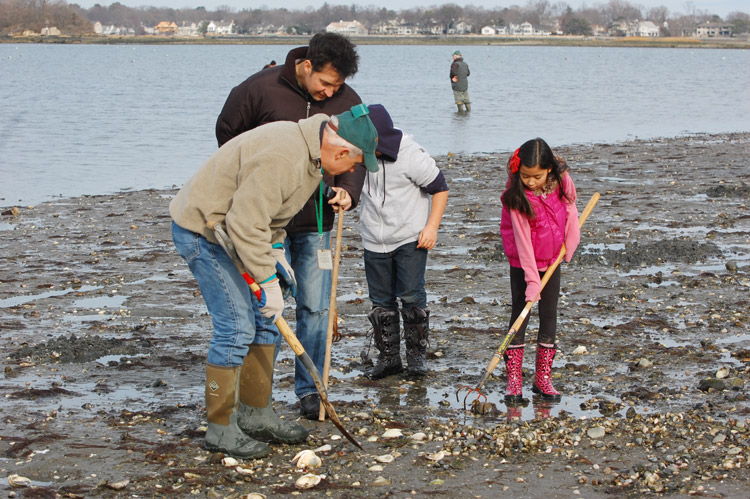Originally written by Carl White.
The Regulated Shellfish Industry
It stands to reason that, given its proximity to Long Island Sound, Greenwich developed a major shellfishing industry. In 1849, the Connecticut General Assembly passed its first act which regulated the planting of oysters and staking of oyster beds in cooperation with shoreline towns. In 1850, residents started planting shells at the mouth of the Mianus River. When they matured, they were sold at market, and the grounds were replanted with fresh shellfish. The bottom had to be dredged to remove vegetable growth and other foreign matter. Starfish had to be removed since they fed on young oysters. By 1855, towns were authorized to appoint a commission to designate places to plant oyster beds. The beds could be no bigger than 2 acres.
Types of Shellfish
Shellfish fall into 2 groups – Crustaceans and Mollusks. Crustaceans include crabs, shrimp, and lobsters. They can be found moving in the water and along the bottom, and have soft shells. Mollusks include clams, oysters, mussels, and quahogs, and are hard-body invertebrates. Oysters are rough, uneven, and oblong. They are found underwater on top of the sand. Clams are oval. They are found under the muck and must be dug out. People use tined forks, rakes, and pitchforks to harvest them. Commercial harvesters use a conveyor belt to gather shellfish from the sea bottom. Small, undersized specimens fall through a screen. Three or four men sort out the glass, junk, and other debris. Crustaceans are invertebrates, meaning they have no backbone. Steamer clams tend to be sandy. They are cleansed in salt water with cornmeal. If allowed to sit after cleansing, they will shoot out sand. If a clamshell is open and doesn’t close, it’s not safe to eat. People can contract hepatitis from clams.
Types of Fishing
There are two types of shellfishing – commercial and recreational. The State controls and licenses all commercial boats. The beds – plots of land underwater – are owned by the fishermen. Towns have no say over grants. Owners can pretty much do what they want with these beds. Over the years, fishermen will trade and sell the underwater land grants. The State sets opening and closing dates with the advice of the community. In 1881, it was estimated that 20 men in Greenwich owned shellfish beds and employed over 100 men.
Overfishing the Shellfish Beds
Towns regulate recreational shellfishing. Although the State had passed legislation that gave authority to the Towns to create Shellfish Commissions, the Greenwich Commission was not very active at first. This changed around 1985. Residents noticed boats in Greenwich Cove (off Greenwich Point) harvesting the beds and taking clams out to a “Mother Ship” out in Long Island Sound. The boats belonged to a Norwalk company. It wasn’t long before the shellfish were cleaned out of the Cove. There were no local regulations to help the Town stop the decimation of the beds.
Concerned citizens decided to approach First Selectman John Margenot. Margenot immediately appointed a Shellfish Commission. Water sampling was begun in 1986 to check on levels of coliform. The State Bureau of Aquaculture set up approximately 55 stations to test water samples. Volunteers offered to use their boats to collect the samples. A part-time Shellfish Coordinator was hired. Representatives from the Aquaculture Bureau met with the Greenwich Shellfish Commission and handed them lots of lists for checking the health of shellfish. In the fall of 1991, the central section of Greenwich Cove was opened for shellfishing, as well as the islands (Great Captain’s and Island Beach). Today you can see signs at Greenwich Point which indicate where shellfishing is currently allowed.
Seeding Beds to Boost Shellfish Populations
Another strategy is the planting of beds to increase the shellfish population. In 1997, ninety-five percent of the Long Island Sound shellfish population had died off. Concerned parties started planting oysters and clams to boost supply. Thirty-thousand oysters were hung off the sides of rafts and used to “seed” the population, and 2-million oysters were planted by hand by 9 Greenwich Shellfish Commission members. This practice continues today to replenish shellfish.
One species of clam that wasn’t that much in demand was the quahog. These were large clams that were used primarily for chowder. Several conservancies reached out to buy large breeder clams to stock other communities such as Shelter Island, Brookville, and Islip on Long Island. Whatever was left over, was sold to markets such as the Atlantic Clam Farms. The money was used to finance the Commission. Over time, the shellfish population grew, and Long Island Sound became the Clam Capital of the East Coast.
The Commission and Its Work
The Greenwich Shellfish Commission members are appointed for four-year terms. They meet 7 times a year and are very attentive to the industry. Members are committed to preserving commercial and recreational shellfish activities. Conservation and management are necessary to ensure the future of shellfishing. It’s because of their efforts that shellfishing is flourishing today.

SOURCES
Jinishian, L; Shellfishing in Greenwich; Greenwich Oral History Project, Greenwich Library, 2006.
Mead, S. Ye Historie of Ye Towne of Greenwich; Knickerbocher Press, Harrison NY, 1911.
ABOUT
Build your family tree, dive into the history of your historic home, and discover photos and articles of days gone past with the Library’s collection of 5,000 books, 800 Oral History transcripts, yearbooks, historical maps, vertical files, pamphlets, periodicals, and microfilm and microfiche. Plus, access resources like American Ancestors, AncestryLibrary, and more with a Library card. Learn more at greenwichlibrary.org/genealogy.
Get the latest about the Library’s History & Genealogy events and offerings sent to your email: greenwichlibrary.org/enews.
Questions? Contact:
Local History Librarian
(203) 622-7948
